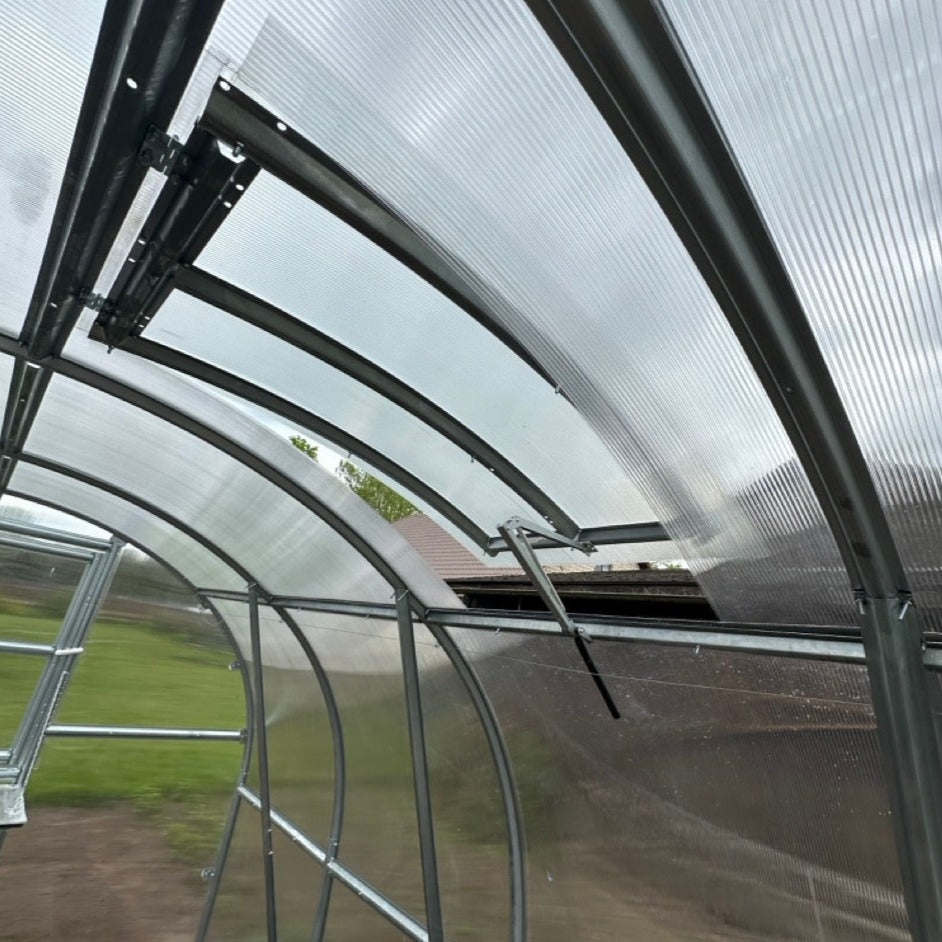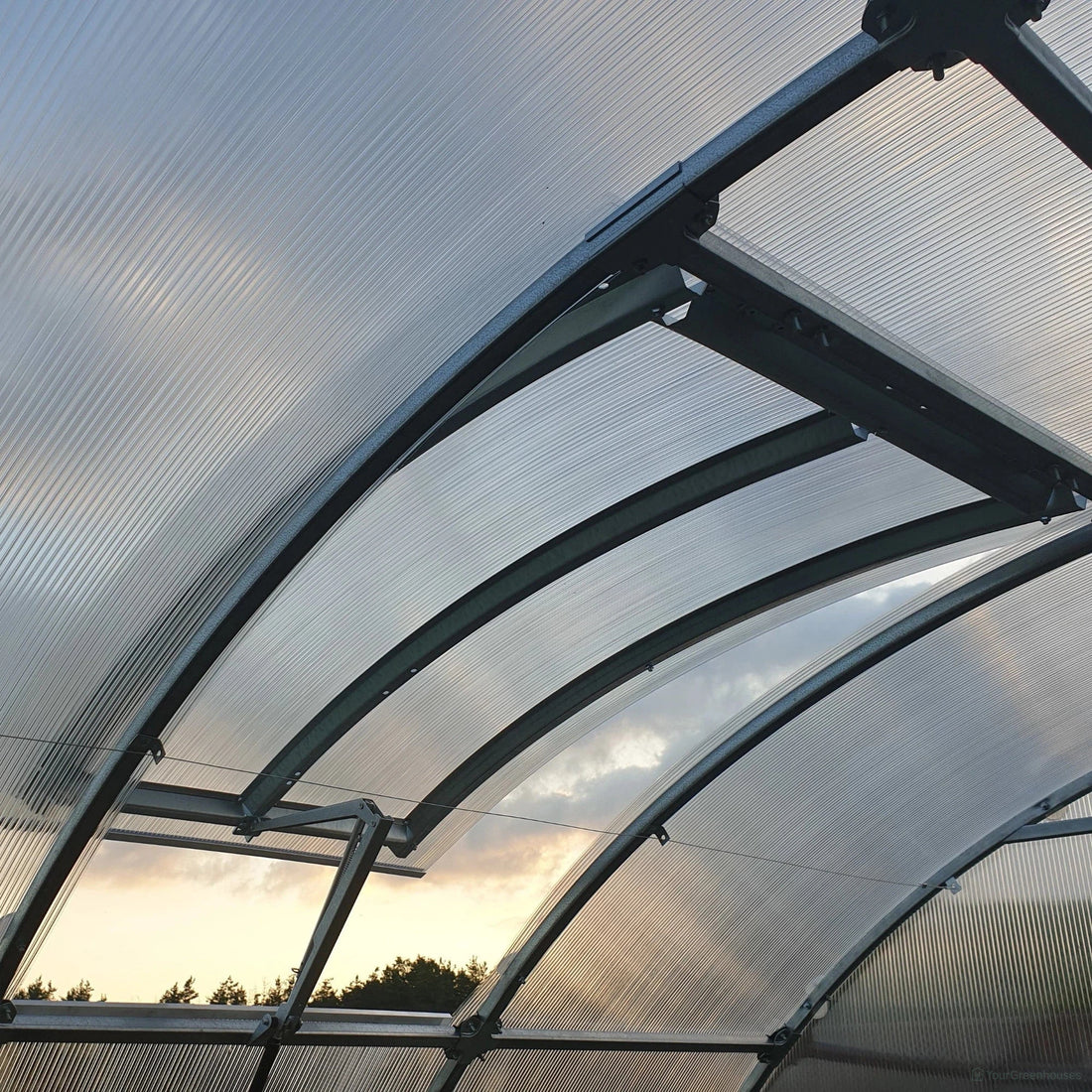How to Install a Greenhouse: A Step-by-Step Guide
Embracing sustainable practices in gardening and agriculture has become increasingly vital in our modern world. One powerful tool in this endeavor is the greenhouse, providing a controlled environment for nurturing plants. While installing a greenhouse may seem daunting, it's a fairly straightforward process you can complete on a weekend with some planning and preparation.
The first step in greenhouse installation is choosing a sunny, level, and well-drained location. Next, pick a greenhouse kit that meets your demands and budget. Then, assemble your greenhouse according to the manufacturer's instructions. Finally, install heating, cooling, and ventilation systems to ensure your plants thrive in their new home.
Alright, let's get deep into the details and learn how to make the installation process a breeze!
Choose the Right Location

Photo by Robert Katzki
Choosing the right location is critical to the success of your greenhouse. Here are some factors to consider when selecting the perfect spot:
Sunlight Availability
One of the most important factors to consider when selecting a location for your greenhouse is sunlight availability. Your greenhouse should be in an area that receives at least 6 hours of direct sunlight daily. Ideally, it should be on your house's south or southeast side, where it can get the most sun from fall through winter. If that's impossible, the east side is the next best option.
Soil Conditions
You should choose an area with well-draining soil that's not too rocky or compacted. If the soil is poor, you may need to add organic matter to improve its quality. Additionally, you should test the soil's pH level to ensure it's suitable for the plants you plan to grow.
Accessibility
Consider a spot that's easy to access from your house and garden and just a short distance from a water source and electricity. It would also be best to make sure that the location is easily accessible for deliveries of materials and supplies.
Select a Greenhouse Kit
Selecting the right greenhouse kit can be the cornerstone of your gardening success. Here are the essential aspects to consider when selecting a greenhouse kit:
Type of Greenhouse Kit
There are several types of greenhouse kits available on the market. The most common types include:
- Lean-to: These greenhouses are attached to an existing structure, such as a house or garage.
- Free-standing: These greenhouses are not attached to any structure and can be placed anywhere on your property.
- Mini: These greenhouses are smaller and ideal for those with limited space.
- Hobby: These greenhouses are larger and designed for those serious about gardening.
Material Considerations
Greenhouse kits are made from a variety of materials, including:
- Aluminum: These greenhouses are lightweight and easy to assemble but may not be as durable as other materials.
- Wood: These greenhouses are sturdy and provide excellent insulation but require regular maintenance.
- Polycarbonate: These greenhouses are lightweight and shatterproof but may not provide as much insulation as other materials.
Size and Layout Options
Greenhouse kits come in a variety of sizes and layouts. The size you pick will depend on your available space and the plants you want to grow. Common layout options include:
- Traditional: This layout features a long, narrow greenhouse with a peaked roof.
- Dome: This layout features a dome-shaped greenhouse that provides excellent insulation.
- A-frame: This layout features a greenhouse with a triangular roof that provides excellent ventilation.
Prepare the Site
 Photo by Rasa Kasparaviciene
Photo by Rasa Kasparaviciene
Preparing the site before installing a greenhouse will ensure it’s stable, level, and able to withstand the elements. Follow these simple steps to do it correctly:
Step 1: Clear the Area
Clear the area of any debris, including rocks, tree stumps, and any other objects that could affect the stability or layout of the greenhouse. This will provide a clean and open space for your greenhouse structure.
Step 2: Level the Ground
The ground where you’ll install your greenhouse should be level to prevent water from pooling inside the greenhouse. Use a shovel or a garden rake to remove any high spots and fill in any low areas.
Step 3: Build a Strong Foundation and Floor
Your greenhouse’s foundation and flooring are crucial for stability and durability. There are several options for greenhouse foundations, including concrete, wood, and gravel. The foundation you choose will depend on your budget and the type of greenhouse you’re installing.
Concrete is a popular choice for greenhouse foundations because it’s durable and long-lasting. If you choose to use concrete, level the ground before pouring it. Wood and gravel foundations are also good options but may not be as durable as concrete.
For the flooring, you can choose from several options, including concrete, gravel, or wood. All of them are great options, but concrete and gravel are durable and easy to clean, while wood brings out a natural look for your greenhouse.
Assemble the Greenhouse

Photo by Ray Shrewsberry
Gather the following tools and materials to start assembling your greenhouse:
- Adjustable spanner
- Foundation layer (either brick or concrete)
- Greenhouse kit
- Knife or scissors
- Ratchet or cordless screwdriver and bits
- Tape measure
- Spirit level
- Gloves and safety goggles
Note: You may need some extra tools depending on your greenhouse type and the instructions, but the ones above are the most commonly required.
Once you have everything ready, proceed with these steps:
Step 1: Read the Instructions Manual
Read the greenhouse instructions manual thoroughly before starting the assembly process. It’ll not only guide you step-by-step through the assembly process but also provide you with essential safety information.
Step 2: Construct the Frame
Open the kit and familiarize yourself with all the available parts to make building the greenhouse easier. Attach the various poles and supports together to create the greenhouse frame.
Step 3: Attach the Panels
Once the frame is strong and in place, attach the panels. This will involve connecting the panels to the frame using the provided hardware.
Step 4: Secure the Structure
Check if all parts of the greenhouse are aligned and level, and then proceed to secure the structure. This final step involves attaching additional hardware, such as doors and vents, and ensuring you anchor them to the greenhouse to the ground.
Install Environmental Controls

Photo by Markus Spiske
Implementing effective environmental control systems fosters ideal conditions for plant growth and contributes to the greenhouse’s overall sustainability and productivity. These systems include:
Ventilation Systems
Installing a proper ventilation system can help regulate the temperature and humidity levels in your greenhouse, as well as prevent the buildup of harmful gases. Plants can quickly become susceptible to disease and pests without adequate air circulation.
There are several types of ventilation systems to choose from, including:
- Exhaust fans
- Intake shutters
- Side vents
- Roof vents
Each type of ventilation system has unique advantages and disadvantages, so you should choose the one that best fits your needs.
Heating and Cooling Systems
Depending on your geographic location, you may need to install a heating or cooling system to regulate the temperature inside your greenhouse.
Common heating and cooling systems include:
- Radiant heating
- Forced-air heating
- Evaporative cooling
- Air conditioning
When selecting a heating or cooling system, consider factors such as energy efficiency, cost, and ease of installation.
Irrigation and Humidity Control
Overwatering or underwatering your plants can lead to root rot or other issues, while high humidity levels can promote the growth of mold and mildew.
Installing an irrigation system can help ensure that your plants receive the proper amount of water, while a humidity control system can help regulate the moisture levels in your greenhouse.
Some common irrigation and humidity control systems include:
- Drip irrigation
- Sprinkler systems
- Fogging systems
- Dehumidifiers
Frequently Asked Questions
How Long Does It Take to Assemble a Greenhouse?
The time it takes to assemble a greenhouse can vary significantly depending on factors like size and type of greenhouse. Generally, a small to medium-sized greenhouse can take a few hours to a full day or two to assemble. Larger or more complex greenhouses may take several days or weeks to complete.
Does a Greenhouse Need a Foundation?
While not all greenhouses may require a traditional concrete or gravel foundation, we often recommend a stable base to anchor the structure and provide adequate support.
Explore Our Premium Greenhouse Options
Installing a greenhouse requires careful planning, attention to detail, and adherence to specific steps to ensure its effectiveness and longevity. By following the outlined process, including site selection, foundation preparation, assembly of structural components, and installation of glazing materials, you can create an ideal environment for cultivating plants year-round.
Additionally, ongoing maintenance and adjustments may be necessary to optimize the greenhouse's performance and address any issues. With proper execution, installing a greenhouse can provide a rewarding space for nurturing plants, extending the growing season, and enhancing the beauty of any garden or landscape.
Ready to leap greenhouse gardening but need help figuring out where to start with installation? Turn to YourGreenhouses team for expert guidance! We offer top-quality greenhouses crafted with ease of installation in mind. Contact us today, and let us help you bring your gardening vision to life!












